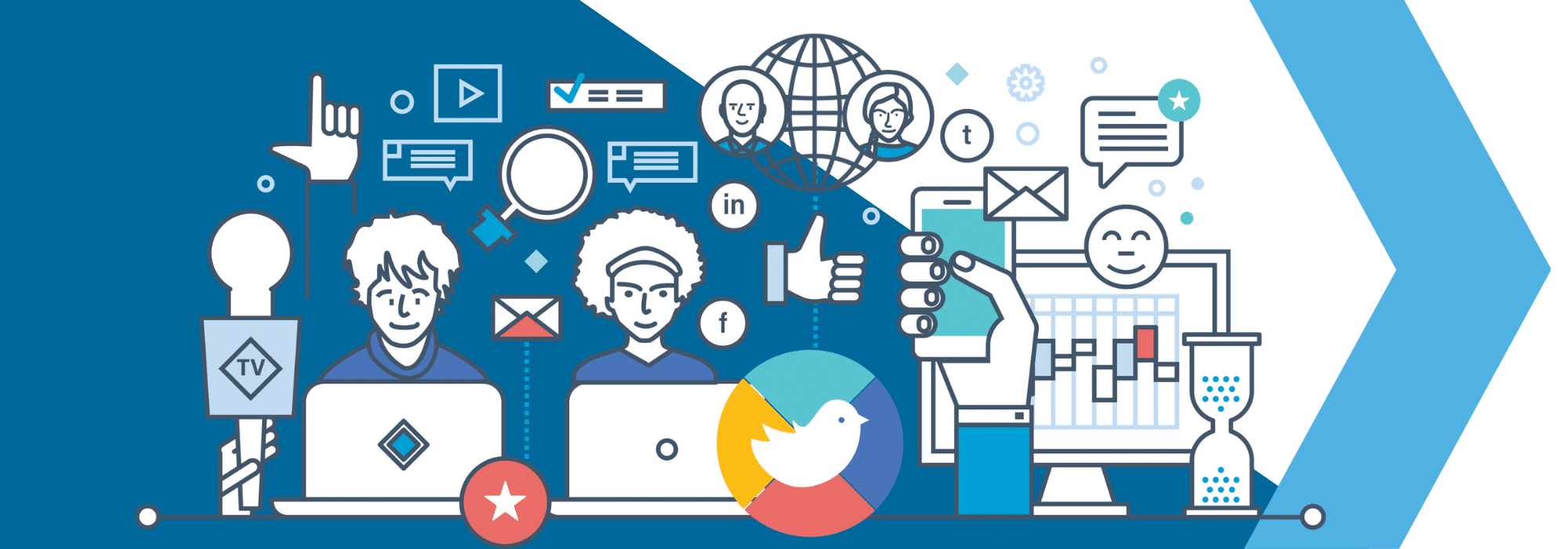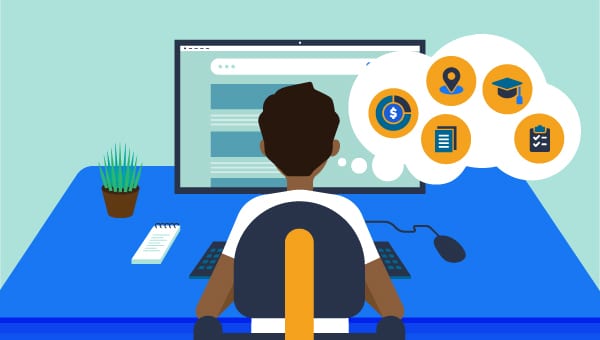Attract and Retain the Right Students for Your Institution
Choosing a higher education program is often a defining moment in a person’s life. Whether it’s a teenager deciding on a traditional, on-ground undergraduate program, or someone in their late 30s selecting an online master’s program — it’s a big decision, and one that can be heavily influenced by the experiences they have with the institutions they’re considering.
Your students don’t just deserve a great experience, they expect it. Which is why identifying opportunities to enhance the student journey at your institution is essential.
In the competitive world of higher ed enrollment, the ability to attract and retain students goes beyond offering picturesque campus views or flexible online scheduling. It hinges on understanding and navigating the complexities of the process a student goes through, from their initial awareness of your program all the way through to their graduation, and identifying where students can get stuck, or worse, drop off.
When it comes to enhancing the student journey, I’m often asked, “Where is the best place to start?” To that end, this article dives into some of the most common areas for improvement. Focus on these areas and you’ll be on your way toward delivering a stand-out student experience.
This article explores:
- Common bottlenecks institutions face at different stages of the student experience
- Methods to identify the most important issues
- Strategies for prioritizing improvements to maximize impact
Common Bottlenecks in the Student Journey
Institutions aiming to enhance the overall student experience need to understand where students tend to get stuck. By pinpointing these bottlenecks, your university can devise strategies that streamline the journey and boost student engagement and retention. Some common points of friction in the enrollment process include:
Top of the Funnel: Driving Awareness
Every student journey begins with awareness, but getting potential students to visit your institution’s website to gain awareness of its programs can be a stumbling block. Many universities face challenges due to poor audience targeting, ineffective creative strategies, or a lack of investment in organic channels like websites and content strategies.
If your awareness efforts are falling short, your potential students won’t land on your university’s digital doorstep. This means opportunities to engage and inform them go untapped, which sets the stage for a cascade of engagement issues downstream.
It’s called an enrollment funnel for a reason — if you don’t attract enough qualified traffic at the top, the bottom of your funnel will fall short of your goals.
Mid-Funnel: Generating Interest
Let’s say your awareness efforts are working, and your brand, story, and program marketing tactics are finding prospective students. Once these prospects are aware of your institution and have visited your site, the next challenge is to convert them into active inquirers. In other words, getting them interested enough to raise their hand by filling out a form, contacting an enrollment advisor, or even starting their application.
This stage often suffers from two main issues:
- Attracting too broad of a range of individuals, including many who are unqualified or not aligned well with the institution’s programs or areas of specialization
- A mismatch between what prospective students expect to find and what the website provides
If your paid ads told one story and your website tells a totally different one, it can be a turnoff for prospective students. If the content does not resonate with potential students’ academic aspirations, they are less likely to take the next step. If you’re not highlighting what makes an education at your institution truly unique or how it connects to your target audience, it’s likely that your content won’t resonate, even if you did identify the right audience.
Bottom of the Funnel: Growing Application Submissions
What’s every enrollment leader’s least favorite word? Melt. Even after marketing to the right audience and generating inquiries, there’s often a drop-off before the application stage — commonly known as the application melt.
This is a delicate phase, where bad strategy moves and overly clunky processes can cause big problems. This could include generic follow-up communications that fail to engage the interests of prospective students, a lack of personalized experiences that can make students feel valued, or insufficient time spent nurturing and managing these warm leads. Each of these factors can lead to a significant reduction in the number of completed applications.
Methods to Identify Student Experience Bottlenecks
Now that we’ve covered the most common bottlenecks, let’s talk about how to identify where these bottlenecks are showing up in your student experience. Once you identify them, you can target improvements effectively and efficiently. Methods to identify bottlenecks include:
Benchmarking
A powerful starting point for identifying pain points is benchmarking your institution’s performance against your peers or similar programs. Benchmarking involves a comprehensive comparison of your processes, outcomes, and student satisfaction levels to those of other institutions.
By evaluating where you stand in relation to your peers, you can identify specific areas where you lag behind. Benchmarking provides a clear, external perspective on your institution’s relative strengths and weaknesses, guiding you toward the most impactful areas for enhancement.
Leveraging Internal Data
Once you understand the external picture, you can dive in internally. Your internal data is an invaluable resource for tracking the effectiveness of changes in the student experience. By analyzing metrics such as enrollment rates, drop-off points, and student feedback before and after implementing changes, you can gauge their impact.
This approach helps you identify which efforts are helping the student experience and which aren’t, allowing you to make data-driven decisions. It also enables you to adapt your strategies dynamically, continuously improving the student journey as students’ needs continue to evolve.
Intuition and User Testing
As we all know, data alone isn’t enough. Intuition and direct feedback play a crucial role in creating the full picture of your student experience. Conducting user testing sessions in which potential or current students navigate your enrollment process can reveal obstacles that data might not capture. This can be as simple as a conversation or as intricate as a survey.
Additionally, personally walking through each stage of the student journey yourself can provide you with insights into the emotional and practical challenges prospective students face. Think of it as acting like a secret shopper — fill out an inquiry form and see what happens. This method helps you uncover hidden roadblocks that might not be evident from quantitative data alone, adding a human element to your analysis.
Fixing Bottlenecks With ICE Scoring
Now that you’ve got a list of bottlenecks to fix, you need a system to prioritize them. This next critical step ensures that you properly allocate your time and resources. The ICE scoring framework, which stands for impact, confidence, and effort, is a structured approach to evaluating potential fixes and deciding which ones to tackle first.
Impact
The first step, impact, involves evaluating how much a potential fix could enhance the student experience.
Fixes that address issues at the top of the funnel, such as increasing awareness and initial engagement, often get a high score because they can influence the largest number of prospective students. The more qualified prospective students you can get into your enrollment funnel, the more you’re likely to enroll.
By prioritizing high-impact fixes, you can see substantial improvements in overall student engagement and satisfaction.
Confidence
Confidence measures how certain your institution is about the effectiveness of a proposed fix. This assessment is based on evidence from user testing, adherence to best practices, personal experience, and insights from experts in the field.
For example, if you get a large volume of inquiries outside of business hours, you can give a high confidence score to an effort that would engage students at any hour, like Onward or a chatbot.
A high confidence score indicates a strong belief that the fix will achieve the desired outcome, reducing the risk associated with resource allocation. You are more likely to succeed when you base your decisions on robust, tested solutions.
Effort
The final component of the ICE framework is effort, which estimates the time, financial investment, and organizational energy required to implement a fix. This step also considers the level of internal buy-in necessary to move a project forward.
Effort scoring helps you understand the resource demands of each potential fix, allowing you to consider its feasibility against its expected benefits. Implementing a new learning management system (LMS) is a huge project that requires organization-wide input and execution. This equals a high effort score. Refreshing your creative assets? Much less effort.
Prioritizing fixes that require reasonable effort but offer significant impact can lead to more sustainable and effective improvements.
Implementation and Iteration in the Student Experience
Improving the student experience is not a one-time thing. It’s an ongoing process that demands continuous attention and optimization. As your institution implements changes, you’ll need to monitor the effects and iteratively refine your efforts based on the outcomes.
Monitoring Results
The first step after implementing any change is to closely monitor the results. Key performance indicators (KPIs), such as cost per lead, application melt, enrollment numbers, student retention rates, and satisfaction scores, are a gold mine. Continuous monitoring validates the effectiveness of new strategies and highlights areas that may require further attention.
Rinse and Repeat
Once the initial results are known, the next step is to apply the ICE framework again — this time to any new bottlenecks or existing issues that were deprioritized in earlier rounds. This iterative approach ensures that your resource allocation remains dynamic and responsive to the evolving needs of your students and your institution.
Ready to Improve Your Institution’s Student Experience?
At Archer Education, we understand the transformative power of full-funnel data visibility when you’re improving your student experience. Our commitment to transparency and knowledge sharing drives our partnerships with colleges and universities, helping higher ed leaders and marketers exceed their online learning growth and enrollment goals.
Our experienced team is adept at identifying and addressing the bottlenecks that can hinder student journeys, utilizing strategies like those outlined in this article to maximize impact. By applying the ICE framework, we help institutions prioritize and implement improvements that significantly enhance the student experience.
If you’re ready to transform your student journey and achieve remarkable outcomes, contact our team today, and explore how our offerings can bring your educational goals to fruition.



